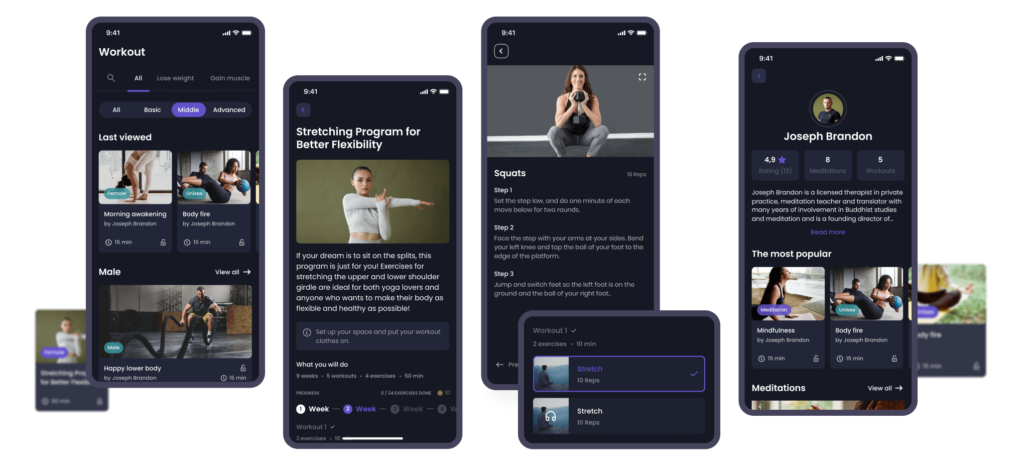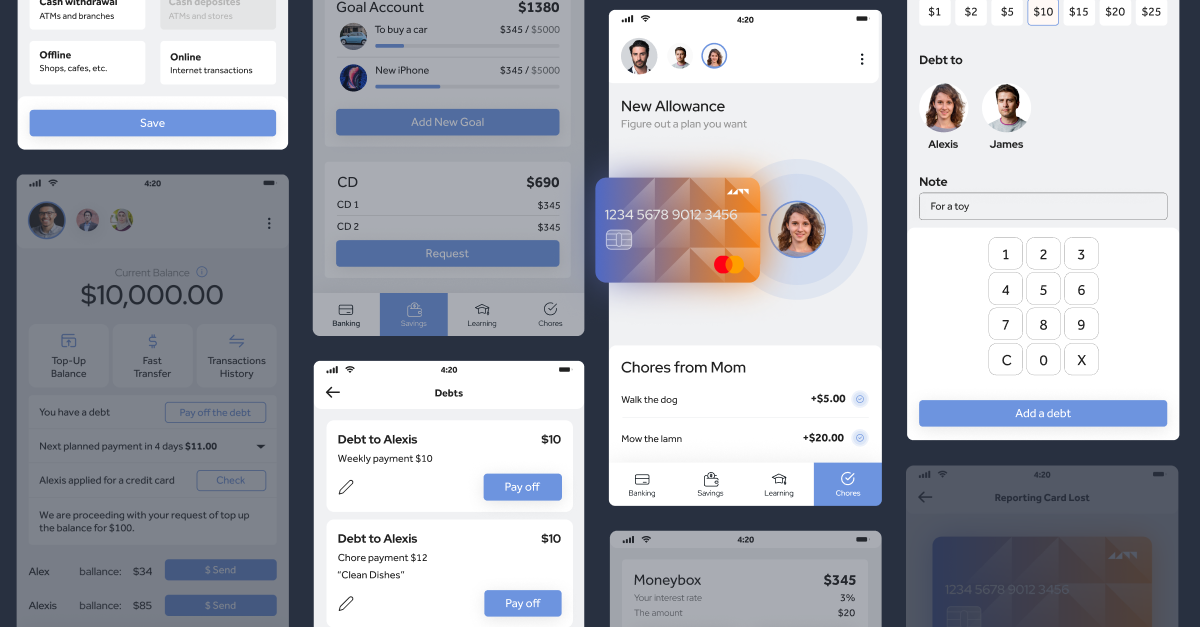Content
According to Google, searches like “mindfulness apps” grew 65% YoY and, according to Fact.MR, the overall value of the mindfulness and meditation app market is projected to reach $180 million in 2032. These numbers suggest that if you want to create your own meditation app, now is the best time to do it due to the global trend for mental health and well-being.
But how do you build an app like that?
In this article, the experts from RewiSoft will share with you their own experiences and tell you how to create your own meditation app with ease!
How to Create a Meditation App Idea Before Investing? [Our Success Story]
In app development, the idea comes first. Clarifying and validating the idea can give you a sense of security and confirm that your business model is viable, which both are important considerations before you invest any money in development.
Recently the team of RewiSoft was developing a meditation app Theraheal. The ultimate goal was to build an app that users want to stay in for 3 months and more. So developing a solid idea before investing was one of our core focuses.


Our experts conducted thorough research to understand what users really want from a meditation app. Some of the insights we’ve discovered include the value of tranquil UI design that helps users stay focused on their mental health and personalization, which provides the best healing experiences.


Also, we discovered the huge role of gamification which can encourage users to build healthy habits and take care of their well-being on a daily basis.
In this article, we will tell you more about how we handled this task and ensured the client’s success.
How to Create a Meditation App in 7 Steps? [Key Insights From Our Case]
Building a solid meditation app is a long and complex process. However, it can be made simpler if you have an actionable plan in mind.
Here is how to create your own meditation app step by step based on our own experience:
Step 1: Clarify Your Business Idea
As was already mentioned, idea validation is crucial for ensuring the success of your project. So it’s always the first step in the development process.
Basically, the process of idea validation consists of four primary steps:
- Defining goals
- Developing a hypothesis
- Experimenting
- Validating
RewiSoft suggests you collect as much information and evidence concerning the target market and your value proposition as possible
You want to test the social acceptance, relative market advantage, compatibility, complexity, and competitive advantages of your product.
Step 2: Do Market Research
After clarifying and validating the idea, you need to do more research to see how your product fits into the existing market. You want to study the competition to see what you’ll have to deal with in the post-development stage. Also, you want to identify the key market trends to know how to make your app stand out.
Finally, you also need to get to know your target users better and define what they are looking for in a meditation app.
Step 3: Start With MVP
Starting with a minimum viable product (MVP) has several purposes. First of all, an MVP consists of only the core features (that might be expanded later), which significantly shortens the time to market. Secondly, building an MVP doesn’t require a large budget, so the initial investment will be manageable.
Finally, creating an MVP will let you test the viability of your product directly in the market and quickly identify the areas for improvement to ensure the success of future iterations.
Step 4: Choose a Monetization Model
In order to receive revenue from your meditation app, you need to find the right monetization method. The options you have include:
- Advertising
- Downloading cost
- Subscription
- In-app purchases
The first two options aren’t good enough for this kind of app as ads can be rather distracting and overwhelming and a downloading cost model doesn’t let users get the feel of the app before paying for it. Subscription and in-app purchases are much better as they let users discover the true value of an app first and then pay.
Step 5: Go to UI/UX Design
Dealing with a meditation app design is rather tricky. An app like this should feel organic and well-balanced. It shouldn’t arouse unnecessary emotions and distract users from their authentic feelings. Therefore, it’s crucial to minimize distractions, leverage color psychology for a tranquil look, and create a usable and personalized UX for maximum satisfaction.
Step 6: Develop and Test
To create your own meditation app, you have to keep the user and their needs in mind. You must seamlessly integrate the core features and complement them with advanced ones for maximum satisfaction.
Ensuring the best client-to-server connection is also a must. By developing both the customer and server sides of the app properly, you can ensure that the connections are supported thoroughly and the app functions flawlessly.
Pay special attention to testing. Quality assurance can either make your app succeed or fail. So you really want to test everything thoroughly.
Step 7: Deploy Your App and Keep Maintenance
When everything’s ready, you can deploy your app in the chosen marketplace(s) and start marketing it. Also, you need to pay special attention to maintenance in order to address users’ needs and challenges timely and deliver the best experiences in the long run. Only this way users will stay with you!
Create Your Own Meditation App Risk-Free [Tech Stack to Use]
Now that you know how to create a meditation app step by step, it’s time to delve deeper into the tech side of the matter. The proper choice of a tech stack is the key to the success of your project.
Here is a brief overview of the most common tech stack that will help you create your own meditation app without any risks and failures:
| Technologies |
|
| Hosting |
|
| Payment gateway |
|
| DevOps |
|
| Push notifications |
|
| Analytics |
|
Top MVP Features to Create Your Own Meditation App
In the how to create a meditation app section of this guide, we highlighted the importance of building an MVP first. So, when designing an app for Theraheal, we also started with building a minimum viable product.
Here are the core features that must be included in a meditation app MVP:
Login
First of all, an MVP for a meditation app must have a login option to let users create their own accounts and receive personalized experiences, while also protecting their data. For maximum convenience, there also must be quick login features via social media.
User Dashboard
The second must-have feature is a personalized dashboard that will let users navigate the app seamlessly and keep the most important information at hand. In our case, we’ve created a personal dashboard with users’ daily activities to help users stay updated on their progress.
Meditation Library
Every good meditation app should offer a solid selection of multi-purpose meditations. Users must be able to access the meditation library from anywhere and at any time to make sure that their progress won’t reverse.
Mood Tracker
A meditation app must provide a solid range of features and tools to let users track their moods and progress. In Theraheal, we created a mood tracker that also analyzes different factors affecting a user’s state of mind and gives helpful recommendations on how to improve it.
Player
When there is a meditation library, an app certainly needs a good-looking and well-functioning player. In our app, we also needed more versatility so that a player could play both meditations and workout videos.
Mental Health Journal
Journaling is proven to be an effective stress and mood management tool. Therefore, in our app, we strived to create a convenient journaling feature that would let users write down their thoughts whenever they want and reflect on their thoughts.
Push Notifications
In a meditation app, push notifications are needed to build a habit and ensure regularity in every user’s engagement with an app.
Payment Functionality
Finally, if you are planning to add in-app purchases to monetize your product, you need to add payment functionality. You need to provide users with a range of convenient and secure payment methods to let users pick what works best for them.
Advanced Features to Create Your Own Meditation App
In order to make your app stand out from the crowd and have users come back to it again and again, it’s important to expand the basic MVP features with some advanced functionality.
Here are some of the greatest advanced features we implemented in Theraheal:
Engaging Onboarding Block
To help users get used to the app, discover its possibilities, and teach them how to make the most out of it, you need to make the onboarding process as intuitive as possible. At the same time, you want to make an onboarding block engaging so that users don’t skip it.
AI-Powered Treatment Plan
Personalization is the key to effective treatment and meditation. In Theraheal, we created a quick quiz that allows the system to analyze every user’s mental health state and needs, and leveraged AI to create personalized care plans for every user.
Audio & Video Messaging
While pre-recorded meditations can improve well-being, therapy is the main key to mental health healing. In our app, we created a one-on-one therapy session option for this purpose and, thus, needed to integrate convenient audio and video messaging features.
Text Chat
This feature is there to deliver prompt and effective customer support right when users need it.
Customized Meditation Podcasts
Apart from the meditation library, in Theraheal we provided users with access to a wide range of great meditation podcasts customized to every user’s needs based on the initial assessment.
How to Create a Meditation App Right [Key Aspects to Consider]
Now that you know about the core features, here are some other key aspects to keep in mind if you want to create your own meditation app:
Specific Design
The design of a meditation app has to be appealing and tranquil at the same time. It should not use bright and disturbing colors or design elements that can distract users or are unnecessary emotions, such as stress or anxiety.
Personalized UX
A good meditation app should be feature-rich and hyper-personalized. In order to attain both goals, developers need to create a sleek UX design that stands for usability, personalization, and seamless experiences.
Gamification Elements
One of the biggest challenges in meditation app development is the low lifetime value (LTV) of such apps. This basically means that users tend to give up on meditation apps in less than 3 months being unable to build a habit.
In order to change this and help users build habits, we’ve integrated such gamification elements as a progress tracking and reward system.
These gamification elements are meant to keep users motivated to continue working on their mental health and, respectively, using their meditation app in the long run.
Mood Tracking Options
Mood tracking is an essential element of well-being. The users of meditation apps should have the possibility to note down and reflect on their moods in order to initiate the healing process. Most importantly, users need to be able to check their mood state on a daily basis in order to create regularity in their mental health efforts.
Unlimited Access to In-App Materials
There is no right or wrong place and time to start taking care of one’s mental health. Many users want to meditate on the go, even without internet access. In order to meet their needs, every good meditation app should provide users with unlimited access to all in-app materials, including the meditation library, mood tracking tools, personal journals, etc.
Chatbot
A meditation app really should have its users covered 24/7 to provide them with answers and assistance right when they need it. The cheapest and most effective way to make this real is to leverage AI-powered chatbots. Such chatbots can take care of users around the clock, help them make the most out of the app, boost personalization, and improve user experience.
Create Your Own Meditation App: Key Design Challenges From Our Case
If you are wondering how to create a meditation app, you must also be aware of the challenges you might face along the way. When building a custom solution for Theraheal, the first set of challenges our team faced was related to design.
Here is what RewiSoft had to overcome to create a flawless meditation app:
UI Design
The core challenge in user interface design was to make it as appealing as possible, yet tranquil. The thing about meditation apps is that they should help users manage their emotions and moods.
Therefore, the app’s design shouldn’t arouse any unnecessary emotions. To achieve this goal, our experts had to leverage the knowledge of color psychology and implement a design that feels tranquil and emotionally neutral.
UX Design
As for the user experience design, we needed to create an app that provides relevant and meaningful experiences to all users. We had to organize everything in the app (from design to function) in such a way that it works seamlessly.
And, most importantly, we needed to create an app where users will want to stay in the long run. Our team’s vast knowledge and expertise helped us achieve these goals.
Сreate Your Own Meditation App: Key Development Challenges From Our Case
Meditation app development is a tricky task. Such apps have to deliver real value and, thus, must provide a broad range of features.
Here are some of the major development challenges our team faced in the process.
Architecture
One of the toughest development challenges in the creation of a meditation app is the construction of the right app architecture. The app we’ve created for Theraheal had to have a variety of overlapping features and a fair amount of pre-recorded meditations and workouts.
We also knew that the amount of content will only increase in the future. So the task was to create an architecture that would let the app scale without related issues.
The right solution was to develop mobile backend services using cloud solutions. By doing this, we received a scaling architecture that allows storing a large number of files and processing data from multiple users.
At the same time, the use of cloud solutions allows seamless synchronization across different devices, minimized battery drain, and reduced on-device data storage.
Streaming Experience
One of the main tasks in the Theraheal project was to deliver seamless streaming experiences to users. The app is supposed to let users stream workouts and meditations at any time and without any issues. To solve the problem, our team had to find the most viable way to stream, host, and store video and audio content to ensure real-time access to it for users.
Integration of Wearable Devices
In the app that we’ve created for Theraheal, we needed to provide users with meaningful workout experiences. The app had to deliver diversified workout programs and let users track their daily activities and mood progress, so we had to make seamless integration of wearable devices.
To do this, we made the app compatible with the PPG (photoplethysmography) sensors used in most wearable devices and created room for seamless synchronization between the app and a user’s gadgets.
Create Your Own Meditation App With Experts [Hiring Tips From RewiSoft]
Outsourcing gives you access to a global pool of development talents. Such diversity offers a lot of potential. Still, picking the best partner to create your own meditation app can be a real challenge.
Here are a few smart hiring tips from RewiSoft to help you make the right choice:
Determine the Team Roles You Need
The standard app development team includes the following roles – a project/product manager, UI/UX designer, developer, and QA engineer. In reality, the team roles and size you need depend solely on the scope and complexity of your project.
So take enough time to define the key specs of your project and identify what talents you’ll need to complete it successfully and timely. Based on the needed team roles, you will be able to filter out unsuitable development partners.
Scan Online Platforms or Look for Referrals
A great way to find a great vendor is to learn what experiences other customers had with it. One way to do this is to check trusted review platforms like Clutch, Trustpilot, and similar for customer testimonials about the agencies of your interest. Another way to pick a good partner is to look for referrals among people you know and trust.
Check Out CVs and Portfolios
CVs and portfolios can also tell you a lot about the chosen vendor. Be sure to scan them for the skills, tech stacks, and project types you are looking for. This will help you ensure that the chosen partner has the expertise and skills to complete your project and guarantee a good result. Also, checking out CVs and portfolios will help you pick the right talents to shape your team.
Interview Candidates and Make an Offer
When you’ve already selected a suitable vendor and reviewed the CVs and portfolios of its specialists, it’s time to run a series of interviews with the candidates you like most. An interview will help you gain a deeper insight into every candidate’s work culture, approach, and experience. So be sure to interview your candidates and make an offer to the ones that match your project the best.
Hire an Experienced Software Development Agency
Finally, the last hiring tip we have for you is to always go with an experienced software development agency. Agencies with vast expertise and many years in the market, like RewiSoft, all have an established workflow and the talents needed to make any project a blast.
Create Your Own Meditation App With Experts [Management Tips From RewiSoft]
Based on our experience, here are a few additional, management tips that will help you get on the same page with your development partner:
Establish Transparent Communication
Often, communication gaps cause the most difficulties in outsourcing and negatively affect the project’s progress and success. Therefore, the first and most important management tip from RewiSoft is to establish transparent communication. Find successful communication channels, pick the right collaboration tools, address gaps and challenges timely, and embrace communication between your teams.
Set Task Priorities and KPIs
Setting task priorities and key performance indicators and communicating them to everyone in a team will add more structure to your project. By doing this, you will ensure that everyone knows their key tasks and objectives and that the entire team works seamlessly towards the ultimate goal. At the same time, KPIs will let you track the performance of the team at every stage of development and measure success.
Choose Effective Tools to Track Team Progress
Effective tracking is another key to success in your project. By keeping an eye on the team’s progress, you will retain more control over your project, receive valuable and timely insights, and, most importantly, will be able to adjust the strategy or make the necessary amendments right when there is a need for them. So you have to pick the right tracking tools.
Encourage Team-Building Activities
In order to make the most out of your project, you need to ensure that your in-house team and development partners are on the same page and have a great rapport. For this purpose, RewiSoft recommends implementing different team-building activities. Such activities will help you strengthen the bond and ensure that a contracted team works as an extension of your inside team.
How Much Does It Cost to Build a Meditation App?
The price for the Meditation App development at RewiSoft starts from $30,000.
The total cost can only be determined after thoroughly analyzing your project and specific needs.
Several factors influence the cost:
- The kind of app development;
- Added features;
- Team size;
- Team location.
There might be other cost-influencing factors too, but these are the most significant ones. In fact, the most important is the location of the contracted team.


How Long Does It Take to Build a Meditation App?
Another crucial question is the time a contracted team will need to complete your project. Like with pricing, the timeframe of every project is unique and depends on a variety of factors, including the type of app, complexity, features, and many others.
In general, we would assume that an app like this will take an average of 1,000 hours to develop.
Create Your Own Meditation App With RewiSoft: Summary
Creating a meditation app that will attract users and make them want to stay isn’t easy. As you already know apps like this often have a very low lifetime value (LTV), so the biggest problem is to make an app that people will continue using in the long-term perspective.
After reading this guide, you should have a better idea of how to create a meditation app step by step, what challenges might be there, and how to ensure success. Now, you only need to find the right development partner and we believe that you’ve already found one!
Having hands-on experience in developing a meditation app with a high LTV, RewiSoft can translate its expertise into your success.
don’t hesitate! Our experts will turn your idea into reality








